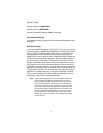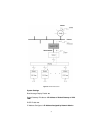26
For a detailed definition of all 2120 system commands, valid entries, and
defaults see Appendix B on page 59.
Note Contact your Network Administrator if you have questions
regarding configuration parameters required for your application
and/or LAN.
3.6 SAMPLE 2120 CONFIGURATIONS
The Model 2120 features and functionality allow it to operate in thou-
sands of different applications; however, this section is not intended to
cover all the possibilities. The configuration samples provided below will
describe some of the typical 2120 applications and the configuration set-
tings required for proper operation and serve as a useful reference when
configuring the Model 2120 for your own application. This section will not
discuss in detail the serial devices connected to the Model 2120 and
related operating systems and/or applications. Actual configurations will
vary from application to application based on the requirements and con-
figuration of the serial device and related operating systems and applica-
tions.
Telnet/TCP Operation
In the typical Telnet/TCP application (see Figure 6), the user has a need
to remotely connect to a serial device located on the LAN for administra-
tion, configuration, monitoring, troubleshooting, data collection, etc. To
enable the remote connection via Telnet session, the Model 2120 is usu-
ally assigned a static IP address. The user then launches a Telnet/TCP
session from their Computer specifying the IP Address of the Model
2120 and port number and remotely connecting to it over the LAN. Once
connected, the Telnet/TCP client converts the asynchronous data into
TCP packets and sends it over the LAN to the IP address of the Model
2120. When received, the Model 2120 converts the packets back to
asynchronous data and forwards the data to the device connected to the
serial interface. The serial device sends asynchronous data back to the
Model 2120 and the Model 2120 converts the data into TCP packets and
sends it over the LAN back to the originating Telnet/TCP client and is
converted to asynchronous data to complete the cycle. Once the
desired tasks are performed, the Telnet session is usually terminated.


















